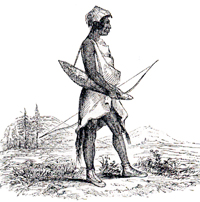
Kalapuya-Amin Discussion Forum:

"How did people live?" "Where did they live?" "And what did the land look like in 1450, and in 1750, in present-day Willamette Valley, Oregon?"
This forum is dedicated to an ongoing scholarly discussion of these questions from a wide variety of perspectives, as listed below. The term "scholarly" is meant to imply that most theories, facts, assumptions, and hypotheses used in the discussions can be referenced to one or more recognized authorities. A growing list of such authorities is the basis for the Kalapuya-Amin Bibliography, included in this website. It also means that, much like a Letters to the Editor column, all writers are clearly identified and written responses are intended to be publicly available as stable, citable sources of ideas and information for years to come.
The focal points of these discussions are the traditional technologies and cultural landscapes of Kalapuya-Amin residents of 1750, and of their ancestral landowners in 1450. Discussions are welcome through nearly any medium: storytelling, oral histories, and technical scientific. However, please limit discussions on topics that are traditionally sensitive to many Tribal Nations, such as spirituality, ceremonies, and the like. This is a forum meant for mutual respectful discourse, please take this into account when posting.
These discussions are moderated for language, a certain amount of grammar, and content. Postings do not necessarily have to be brief, but they do need to be on topic. Writings are intended to be viewed indefinitely, so some humor is encouraged.
Discussion Board. [Planned to be online in October, 2006, following the Symposium, and remain online through publication, review, and discussion of Proceedings.]
Theme |
topic #1 |
topic #2 |
topic #3 |
topic #4 |
topic #5 |
topic #6 |
1450 AD
|
city-states
|
farmers
|
migrants
|
trade | warfare
|
wasteland
|
| 1750 AD | city-states
|
farmers
|
migrants
|
slaves | trade | warfare
|
Artwork
|
designs
|
dyes
|
materials
|
methods
|
symbols
|
uses
|
Baskets |
designs |
materials |
methods |
structures |
uses |
|
| Clothing | materials |
methods |
styles |
uses |
||
Cooking |
condiments |
fruits |
meats |
methods |
recipes |
vegetables |
| Cordage | materials
|
methods
|
tools
|
types
|
uses
|
|
Crops |
burning |
digging |
harvesting |
planting |
pruning |
seeding |
Fishing |
locations |
methods |
seasons |
species |
tools |
|
| Fuelwood | locations |
methods |
species |
tools |
volumes |
|
| Housing | campgrounds |
cities |
temporary |
towns |
||
| Hunting | locations
|
methods
|
seasons
|
species
|
tools
|
|
| Language | local |
names |
national |
neighbors
|
sign
|
trade
|
| Lithics | cooking |
crafts |
fishing |
hunting |
warfare |
|
| Population | campgrounds
|
cities
|
roads
|
towns
|
||
| Slaves | field |
home |
owners |
trade |
victims |
|
| Stories | family
|
historical
|
teaching
|
traditional
|
training
|
|
| Trade | centers |
partners |
products |
routes |
||
| Transportation | canoe |
foot |
international | local
|
national
|
|
| Weaving | designs
|
materials
|
methods
|
products
|
styles
|
uses |
| Woodcarving | designs
|
materials
|
methods
|
structures
|
tools
|
uses |
©2006 Oregon Websites & Watersheds Project, Inc.